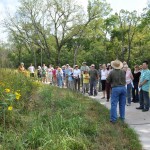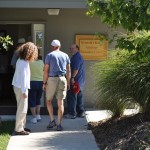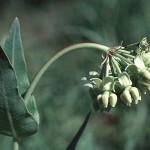Our medicinal research garden is the newest tract in the 3,400-acre KU Field Station

One of the most visible elements of the Native Medicinal Plant Research Program — our medicinal garden north of Lawrence — is also the newest addition to the several land tracts that together make up the University of Kansas Field Station.
What is a field station? The website for the Organization of Biological Field Stations, an association of more than 200 field stations and professionals, describes these areas as places that “provide living libraries and outdoor laboratories for students, researchers, and the general public interested in the environment.”
KU’s own Field Station, established in 1947, is managed by the Kansas Biological Survey, where our program has its botany offices. The Field Station has grown in the past six decades to comprise eight separate land areas. They include diverse habitats of forests, wetlands and prairies that provide the setting for research and education on endangered species, climate change and the impact of various chemicals on the environment. Some parts of the Field Station serve primarily to preserve and help protect rare but ecologically significant habitats in northeast Kansas, including remnants of original prairie and eastern deciduous forest.
The largest portion of the Field Station, an area of about 1,600 contiguous acres north of Lawrence, includes public trails and shelters. It also is the site of the Armitage Center, a facility equipped to host events and retreats for university and area groups.

The oldest part of the Field Station, the 590-acre Fitch Natural History Reservation, has a rich history that dates back to the founding of Lawrence. Dr. Charles Robinson, first governor of Kansas, founded the Free State Party in 1855; it came to have a leading role in the abolitionist movement here. While traveling through this area on his way to the California gold rush in 1849, Robinson observed rolling hills on the south side of the Kansas River that he decided would make an excellent site for a prosperous community.
Returning to Boston, he helped found the New England Emigrant Aid Society and, in 1854, led the first party of immigrants back to the Territory of Kansas to establish Lawrence and create an abolitionist stronghold. Robinson and his wife, Sara, originally settled on Mount Oread, the future site of the university’s main campus. Soon after, they donated this land to the fledgling city, specifying that a university should be built on it. They moved north of town to the Field Station site now known as the Robinson Tract.
At Sara Robinson’s death in 1911, the majority of couple’s vast land holdings north of the Kansas River were donated to KU. The university donated much of this land to the city, and KU Endowment, the private, nonprofit foundation for KU, retained ownership of what remained. About 700 acres of land deeded by the Robinsons is now within the largest part of the Field Station north of Lawrence.
In 1948, Henry Fitch, KU professor of herpetology, and his family built a house on what is now called the Fitch Natural History Reservation. Fitch studied plant succession — how the population of plants in a specific area changes over time — within this land area. He spent nearly 60 years tracking the effect of these changes on animal species and communities, providing a valuable data set and model for similar studies.
The Rockefeller Experimental Tract was added to the Field Station in 1956. It was purchased with funds donated by the philanthropist John D. Rockefeller Jr., who briefly met E. Raymond Hall, director of the KU Natural History Museum, at a conference in Washington, D.C. Two weeks later, Hall received a handwritten note and a $17,000 check to cover the cost of a parcel of land he wanted to acquire for KU. This 160-acre parcel includes the 10-acre Rockefeller Prairie remnant, a rich example of original prairie that will be a regular part of our program’s semi-annual spring and fall tours along with our medicinal garden.
The eight areas of the Field Station serve a variety of important roles. The Hall Nature Reserve, a 160-acre site northwest of Lawrence donated in 1998 by Raymond Hall’s son and daughter-in-law, “Hub” and Kathleen Hall, includes both native prairie and woodlands. The 108-acre Robinson Tract, Charles Robinson’s namesake, is a diverse area with wetlands, savannah-type forest and prairie.
The 1,370-acre Anderson County Prairie Preserve, five miles south of Garnett, Kansas, is owned by The Nature Conservancy and managed by the Kansas Biological Survey as part of the KU Field Station. Preservation of this area helps maintain and enhance native biodiversity in the imperiled tallgrass prairie ecosystem and protects critical habitats for several rare species of plants and animals, including Mead’s milkweed, the greater prairie chicken and Henslow’s sparrow. Careful management of the preserve also supports research, education and outreach.
The Breidenthal Biological Reserve, Rice Woodland and Wall Woods, all south of Lawrence in the Baldwin Woods, have richly diverse forest areas. Research in the Baldwin Woods, which has been designated a National Natural Landmark, includes old-growth forest and the westernmost stand of sugar maples in the U.S. All human activity here is nondisruptive, with a stewardship focus on preservation.
In contrast, the John H. Nelson Environmental Study Area, added in 1972 at the north end of the 1,600-acre contiguous area north of Lawrence, serves as the Field Station’s headquarters and provides a large space for researchers to study different habitats. The Field Station’s operations and administrative offices are located here. The Kansas Aquatic Mesocosm Program facility at the Nelson area provides more than 100 experimental ponds that, together with several larger reservoirs, are used for various aquatic studies. Terrestrial areas at the Nelson area are used for intensive studies of insects, reptiles, small mammals and birds. An research biotic succession area and other parts of the Nelson area are used extensively for a variety of plant studies.
The Armitage Center, opened in 2008, is a valuable addition to the Nelson area. Constructed with funding from the National Science Foundation, the center features a large classroom that also functions for smaller meetings and conferences, plus several wet and dry laboratories, observation rooms, and full kitchen and bath areas. The center supports the Field Station’s increased focus and attention in recent years to all levels of education and public outreach.
Many new and ongoing research projects take place at the Field Station, such as study of the Topeka Shiner, an endangered species of fish. Discovery of the optimal conditions under which Topeka Shiners can be induced to reproduce, along with other research findings, is being used in federal efforts to recover this species in the wild.

An 18-year research project on the Rockefeller Prairie has focused on the study of Mead’s milkweed, a federally threatened plant species. Researchers have painstakingly marked the locations of Mead’s milkweed plants, tracking their survival, spread and mode of reproduction.
Other projects have focused on everything from insect behavior to soil sampling. One particularly interesting project has involved collaboration between researchers and engineers to determine the potential of algae as fuel. KU faculty also have been involved with the KU student chapter of Engineers Without Borders, building and testing composting latrines in an effort to improve sanitation systems in rural areas of Bolivia.
The Field Station will continue to be an important asset to KU students and faculty in the future. An increased interest in outreach will bring the public closer to the Field Station projects and research that help improve the environment and provide a place for people of all ages to learn about the natural world.
